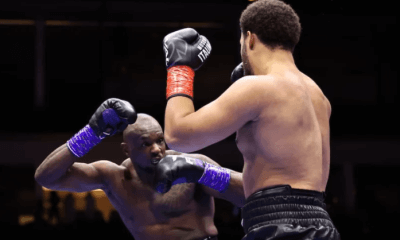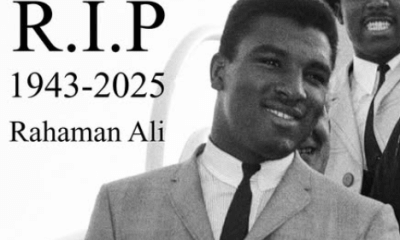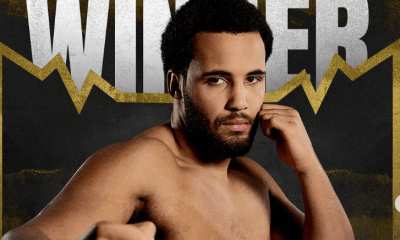Featured Articles
Remembering Lightweight Contender Frankie Narvaez, Boxing’s Peerless Riot-Maker

Remembering Lightweight Contender Frankie Narvaez, Boxing’s Peerless Riot-Maker
The death earlier this month of Marvin Hagler evoked memories of his bout in London with Alan Minter. Hagler launched his middleweight title reign that night, a reign that would last through 12 successful defenses.
Minter was a bloody mess when his corner pulled the plug in the third frame, but the fight would be overshadowed by the aftermath. Alan Minter’s ardent following was pocked with hooligans. They showered the ring with plastic bottles and beer cans, many with their contents undisturbed. A cordon of police kept Marvin from being assaulted by the mob as he made his way back to his dressing room. Veteran British scribe Harry Carpenter called it the darkest day in British boxing history. Former heavyweight contender Henry Cooper, one of England’s most admired sportsmen, said, “I feel degraded to admit I am British.”
British boxing fans are (how should I put it?) notoriously un-phlegmatic. But the Brits certainly don’t have a monopoly on post-fight riots. Over on this side of the pond, the partisans of Frankie Narvaez were every bit as volatile as the partisans of Alan Minter, arguably more so as they were more persistent.
Frankie Narvaez was born in Puerto Rico. In common with many of his countrymen, he had one foot in New York City as he was growing up, often shuttling between the Big Apple and the island of his birth. He took up boxing in New York and made his pro debut in February of 1961 in a four-round bout at Madison Square Garden. He made great headway although he could not give the sport his full attention. His day job was that of a porter at the New York State Workman’s Compensation Bureau.
Narvaez didn’t pack a hard punch, but he was a high-pressure fighter who constantly bore in on his opponent. Standing only 5’3 ½”, he really had no alternative. His opponents were invariably taller and longer-limbed and he had to penetrate their guard to be successful.
In a story that appeared in the Syracuse Post-Standard, Jerry Izenberg said, “(Narvaez) is a straight-ahead type of fighter with very little deception and a vicious left hand.” Izenberg further alleged that there had been an “incident” at one of Narvaez’s amateur bouts when Frankie was on the wrong end of a rank decision. He did not elaborate.
Narvaez developed a nice rivalry with Johnny Bizzarro, the pride of Erie, Pennsylvania. He won their rubber match, elevating his record to 24-2-1, and that earned him a date with the great Filipino boxer Gabriel “Flash” Elorde. “Flash” was the reigning world super featherweight champion, but his title wasn’t at stake when he crossed swords with Narvaez in a 10-rounder at Madison Square Garden on Aug. 4, 1965.
The bookmakers actually installed Narvaez the favorite, but that didn’t dissuade people from betting on him, even after the odds were steamed up from 7/5 to 11/5. The lopsided betting wasn’t entirely a reflection of regional bias. The Filipino was only 30 years old, but he had a lot of mileage on him.
The fight was a bruising and bloody affair. In the late rounds, Narvaez appeared to be the fresher man. He had a style that played well in the cheap seats, but ringside reporters, in the main, also thought the decision should have gone his way. In a post-fight poll, the tally was 13-9-4 for Narvaez.
One of the judges scored the fight 7-2-1 for Narvaez but he was overruled by identical scores of 5-4-1 for Gabriel Elorde. When the scores were read, all hell broke loose. Narvaez’s partisans left the famous arena in shambles. The house organ was among the furnishings that were damaged. It was toppled from its perch in an alcove five feet above the floor. (This marked the first time, said the wags, that an arena needed an organ transplant.)
Riot police were called in to quell the disturbance. The last of the miscreants bolted for the exits after being doused with a fire hose.
There was another convulsion when Narvaez fought Panama’s Ismael Laguna at Madison Square Garden on March 10, 1987. The flashy Laguna, who had won and lost the lightweight title in bouts with Carlos Ortiz, was too slick for Narvaez, winning the 12-round bout by scores of 9-1-2, 8-3-1, and 7-5. But to Narvaez’s credit, he never took a backward step.
One would have thought that the clear-cut decision would have quieted Narvaez’s supporters, but not so. As Jim Murray phrased it, they were not incensed by the verdict, but by the arithmetic.
Unlike the first riot, the building wasn’t mutilated, but folks seated near the ring were in greater jeopardy. Many in the pro-Narvaez contingent, who streamed into the Garden from Spanish Harlem and the Bronx, smuggled bottles of liquor into the arena. The bottles crashed down from the balcony, littering the floor with shards of glass. Eleven people were cut by the shrapnel, five of whom, including a UPI reporter, were treated for minor lacerations at a hospital. TV announcer Don Dunphy, among other members of the media, stayed out of harm’s way by taking shelter under the ring.
Not quite 10 weeks later, there would be another wild scene at Madison Square Garden when Dick Tiger, in a mild upset, successfully defended his world light heavyweight title with a razor-thin decision over Jose Torres. A Puerto Rico-born New Yorker, Torres did his best work in the late rounds but it was too little, too late, in the eyes of two of the judges.
The situation had become intolerable. In words that would not have passed muster with his editor today, New York Times sportswriter Dave Anderson, a future Pulitzer Prize winner, identified the root of the problem as “the flammable nature of the Hispanic temperament.” There was talk of barring Puerto Ricans from future boxing events at Madison Square Garden. Harry Markson, the arena’s director of boxing, said this wasn’t feasible. Roughly 800,000 first- and second-generation Puerto Ricans then resided in New York, 10 percent of the city’s population. The Garden could not afford to lose this demographic, but Markson agreed to a cooling-off period.
An interesting offshoot of the brouhaha was the August 16, 1967 world lightweight title fight between Laguna and Carlos Ortiz, the latter of whom, like Jose Torres, was a New Yorker born in Puerto Rico. This was the third and final meeting between the two great lightweights.
As a precaution, Madison Square Garden planted the fight at Shea Stadium in Queens, the home of New York’s newest professional teams, the Mets and the Jets. Two hundred special policemen were hired from private companies to assist the regular police detail. They were not needed. Ortiz regained his title before a peaceful gathering of 19,480. (This was likely the first fight in boxing history where the combatants embraced before the first bell. This was by pre-arrangement and meant as an encouragement to good sportsmanship.)
Believe it or not, Madison Square Garden invited Frankie Narvaez back again. On the surface this was insane, a prescription for more trouble, but when Narvaez fought Laguna’s protégé Antonio Amaya on August 20, 1968, the circumstances were far different. For one thing, this fight went early in the program, preceding bouts featuring Laguna and Benny Briscoe. That gave the hooligan element within Narvaez’s fan base less time to cast off their inhibitions.
Of greater importance, this was a new Madison Square Garden. The six-month-old building, which was erected atop Penn Station, had a different configuration than its predecessor. The folks in the cheap seats were farther away from the action. If some fool threw a bottle off the balcony, said Dave Anderson, it had scant chance of landing near the ring unless the fellow had an arm like Pittsburgh Pirates right fielder Roberto Clemente.
Narvaez’s fight with Amaya was a ho-hum affair. Frankie looked slow and lost a wide decision. He would have eight more fights before quitting the sport, finishing 39-11-1.
There would be more unseemly incidents at Madison Square Garden, incidents where one couldn’t point the finger of blame at Puerto Ricans. The first fight between Andrew Golota and Riddick Bowe, staged on July 11, 1996, engendered a riot that was among the worst of the worst in the annals of prizefighting in New York. But that’s a story for another day.
Frankie Narvaez was 64 years old when he passed away in 2004. He left this world quietly; there was no mention of it in English-language newspapers. That was quite a departure from his heyday as a main event fighter at the old Madison Garden where he was a lightning rod for noise that would shake the rafters.
Check out more boxing news on video at the Boxing Channel
To comment on this story in the Fight Forum CLICK HERE
-

 Featured Articles4 weeks ago
Featured Articles4 weeks agoThe Hauser Report: Zayas-Garcia, Pacquiao, Usyk, and the NYSAC
-

 Featured Articles3 weeks ago
Featured Articles3 weeks agoOscar Duarte and Regis Prograis Prevail on an Action-Packed Fight Card in Chicago
-

 Featured Articles2 weeks ago
Featured Articles2 weeks agoThe Hauser Report: Cinematic and Literary Notes
-

 Book Review2 weeks ago
Book Review2 weeks agoMark Kriegel’s New Book About Mike Tyson is a Must-Read
-

 Featured Articles4 weeks ago
Featured Articles4 weeks agoRemembering Dwight Muhammad Qawi (1953-2025) and his Triumphant Return to Prison
-

 Featured Articles6 days ago
Featured Articles6 days agoMoses Itauma Continues his Rapid Rise; Steamrolls Dillian Whyte in Riyadh
-

 Featured Articles3 weeks ago
Featured Articles3 weeks agoRahaman Ali (1943-2025)
-

 Featured Articles3 weeks ago
Featured Articles3 weeks agoTop Rank Boxing is in Limbo, but that Hasn’t Benched Robert Garcia’s Up-and-Comers


















